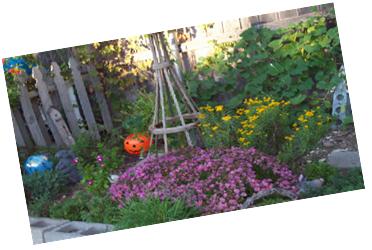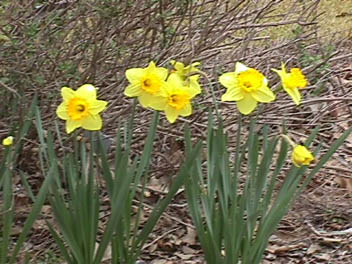Gardening Calendar
Use this schedule for your gardening calendar year:
January:
January is the time to look through seed catalogs and online to order seeds for the spring garden. Seeds will be slow to sprout in the cold of winter, so you may want to start them indoors. Cool season crops include all the lettuces and greens, as well as root crops.
Mid-January: order seeds and seed starting supplies if you are going to start your warm-season vegetables indoors under lights. You can start most vegetables indoors to transplant to the garden except for root crops, which generally do not like to be transplanted. Wait until February to plant these.
Plant bareroot shrubs and roses (this is the second best time; fall is the first).
February:
Believe it or not, February is the beginning of spring here in Central Texas. If the winter is especially cold, you will may have to replant seeds you plant this month if they are damaged by freezing weather. Just keep trying until you are successful. Don't plant any warm-season vegetables yet as they cannot withstand freezes. Cool season vegetables are defined here as those of which you eat the roots or leaves, while warm season vegetables are those of which you eat the fruits, such as tomatoes (yes, that is a fruit).
Clean up beds for spring planting and dig in some compost to help renew the vitality of the soil.
Drip irrigation can do wonders for your plants. It waters deeper and more efficiently. Less water is lost to evaporation. Water does not get on the leaves to aid fungi and diseases from developing. Each year, install another drip irrigation bed and spread the cost over several years. You will be happy you did. Your plants will do better than ever.
Around Valentine's day trim back roses by one third and fertilize them with nitrogen fertilizer. Also, plant potatoes and transplants of broccoli if you didn't plant broccoli in the fall like you should have. Install a fabric row cover over your growing vegetables to help them survive frosts.
If you haven't already done so, this is your last chance to start transplants of tomatoes indoors. Start moving transplants of warm season vegetables outdoors in good weather to get them acclimated to the harsher conditions of the garden. Move them in at night.
You can plant transplants of cool season flowers now. These include pansies, snapdragons, dianthus, allysum, and poppies. Your best time for planting these flowers was in the fall, but you can still try planting them now.
Get your lawn mower serviced and the blades sharpened before you need it done in the spring.
March:
March is one of those months that can be really springlike one day and winter the next. We can still get frosts in March, so be careful what you transplant into the garden. It is less risky to repot transplants into larger pots and move them outside on good days and move them inside when the weather turns fowl again.
Plant second or third plantings of cool season vegetables to extend the harvest. Toward the end of the month, you can risk planting warm season flowers and vegetables directly in the garden. You can also plant cool season herbs, which is practically speaking, everything but basil. Once again, you should have done this in the fall for better results.
When the leaves start to fall off your oak trees, run your lawn mower over them. This needs to be a mulching lawn mower. It will chop up the leaves finely. You will need to move slowly across the lawn, taking about four times as long as a regular mowing. This is the only time I recommend using the bag attachment with the lawn mower. As it becomes full, stop the lawn mower and go empty the bag anywhere in flower or vegetable beds that does not have a covering of mulch. These mulched leaves will break down and add wonderful compost to the soil. To protect against high winds, cover them immediately with some heavier material such as twigs, bark, or commercial mulch. I never rake a lawn. I don't own a rake. Mowing the lawn like this several times in the spring is easier on the back than racking. I sweep leaves where I can't mow them. Since the mulched leaves make such excellent mulch and turn into wonderful compost, I consider them a valuable asset to the garden. You will love how neat your lawn looks after you finish this process. You can repeat this once or twice until it is now longer needed. By that time, you will return to regular mowing of grass instead of leaves. Do not use the bag again until next spring! Mulched lawn grass leaves provide a great deal of nitrogen to the lawn and they are free.
In late March you can plant shrubs, perennials, annuals, vegetables, and anything else you would like. It is the second best time to plant, extending into April. Once the weather starts to be too warm again, you need to stop and wait for fall, the best time of the year to plant.
April:
April is my favorite month of the year. You should be harvesting cool season vegetables and enjoying the lovely flowers that are blooming now. The weather is cool and wonderful and it is a delight to be outside.
Fertilize your lawn after you have mown it twice. Do not use weed and feed; it will not help now as weeds have already germinated. Even organic weed and feed products such as corn gluten meal will not kill weeds now. Just use a nitrogen fertilizer.
You can also fertilize your flowers and vegetables now. If this is your first year to garden in a particular spot, then use a complete fertilizer, which means it has numbers like 10 10 10 on it. From then on, you can use a straight nitrogen fertilzer. I recommend ammonium sulfate.
May:
May should be a great month for eating homegrown produce and enjoying your flowers. You can fertilize your flower and vegetable beds again according to package instructions. Don't think that adding more fertilizer than the instructions say is going to make your plants grow more or be healthier. Just follow the instructions.
It will be hot and you will be concerned with watering your lawn and beds. Water so that you apply an inch of water each time you water and then don't water again for a week. If it rains, don't water unless it was one of those whimpy rains that did nothing but wet the top of the soil. Use your index finger to determine the level of soil moisture. It should be moist and cool an inch down.
June:
June can be a great gardening month or not, depending on how hot it gets. Some Junes are mild and rainy, while others are hot and dry. Much of your success in the vegetable garden will be determined by the kind of June you have. Be sure to water when rainfall is not adequate, but nothing is as good as rainwater. If you don't have rainwater storage barrels, add them whenever possible. You can at least water your vegetables with this water if their is a drought and water restrictions.
Deadhead flowers that have finished blooming so more will grow. Also, keep in mind that crisp, brown plant material is a fire hazard. Whenever possible, keep your lawns and gardens watered to cut down on this risk.
July:
July brings hot weather and usually drought conditions. Be diligent and water. Containers may even need to be watered everyday if the temperatures reach triple digits. Check before watering to see if the soil is no longer moist and cool. Don't overwater as that can kill plants as quick as letting them completely dry out. Lawns and outdoor plants should be watered deeply once a week.
If you are going to grow vegetables for a fall garden that take several months to harvest, you have to plant in July. This means plant tomatoes now.
August:
August is a really challenge for gardening. August: Even though it is blistering hot, August is an important month in the garden. Plant warm season vegetables such as tomatoes for a fall garden.
It is also time to prune roses back by one fourth. After pruning fertilize roses with a nitrogen fertilizer.
Be sure to keep everything watered deeply once a week. Water fall transplants every two or three days if they start to dry out.
You can start cool season vegetables indoors now to transfer outside when it cools off in the fall.
Replenish mulch in all planting beds.
Deadhead flowers with spent blooms.
Water the lawn very early in the morning.
Quit pruning back mums.
September:
Fall gardening begins in earnest.
Now is the time to order spring blooming bulbs that you will plant in late fall or winter.
You can plant some cool season annuals now such as petunias but don't plant pansies yet because it's just not cool enough yet.
Once this month you can apply a nitrogen fertilizer to flower and vegetable beds.
Plant wildflower seeds this month. As it begins to cool off, plant shrubs and perennials, as well as herbs in the garden.
You can apply a pre-emergent herbicide to your lawn now. If you have trouble with brown patch now is the time to apply a granular fungicide.
Fertilize rosebushes to extend their blooming time.
Plant cool season vegetables as the weather begins to cool off. Any perennials, shrubs, or winter flowers will do much better in the spring if you plant them now.
October:
All your cool season flowers should be blooming nicely now, and your cool season vegetables should be giving you fresh produce for your dinner table.
You can plant some cool season vegetables this month including: Beets, broccoli, brussels sprouts, carrots, greens, onions, spinach, Swiss chard, and turnips. As a matter of fact this is the perfect time to plant onions and garlic. These will grow all fall and winter and be larger and more productive in the spring.
Once it has cooled off completely you can plant cold season flowers such as pansies, snapdragons, sweet peas, and stock. Before planting sweet peas soak them overnight to soften their coating. They will grow in the winter and bloom beautifully in the spring.
Prepare for the first freeze. Have fabric row cover ready to cover plants.
When you have not mowed for half a month you can fertilize your lawn.
November:
Fertilize your cool season flowers, and make sure that they do not dry out.
Be sure to water if we have winter drought conditions. Without enough water plants become vulnerable to freezing easier.
Do not prune plants at this time; wait until after spring blooming.
You can fertilize any flowers or vegetables that are still growing.
Order gifts from catalogs for your gardener friends and family.
December:
Plant spring flowering bulbs now.
Plan garden expansion projects now.
If the weather is nice get out and work on expanding your garden while it is cool.
Now is a good time to do a soil test. Contact your county extension office and they will be able to tell you what you need to do.
Plant trees and bare root roses now.



